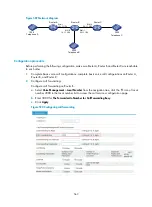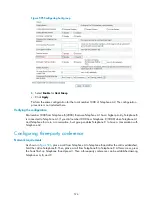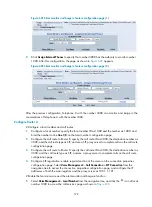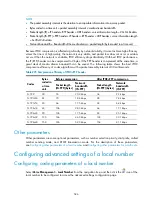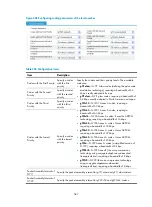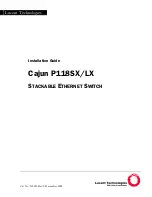
582
Advanced settings
This section provides information on configuring various advanced settings.
Introduction to advanced settings
Coding parameters
The configuration of coding parameters includes specifying codec priorities and packet assembly
intervals.
The codecs include: g711alaw, g711ulaw, g723r53, g723r63, g726r16, g726r24, g726r32, g726r40,
g729a, g729br8, and g729r8.
The following are the characteristics of different codecs.
•
g711alaw and g711ulaw provide high-quality voice transmission, while requiring greater
bandwidth.
•
g723r53 and g723r63 provide silence suppression technology and comfortable noise. The
relatively higher speed output is based on multi-pulse multi-quantitative level technology and
provides relatively higher voice quality. The relatively lower speed output is based on the
Algebraic-Code-Excited Linear-Prediction technology and provides greater flexibility for
application.
•
The voice quality provided by g729r8 and g729a is similar to the adaptive differential pulse code
modulation (ADPCM) of 32 kbps, having the quality of a toll. Also, it features how bandwidth,
lesser event delay, and medium processing complexity. Therefore, it has a wide field of application.
Table 216
Relationship between algorithms and bandwidth
Codec Bandwidth
Voice quality
G.711 (A-law and
μ
-law)
64 kbps (without compression)
Best
G.726
16, 24, 32, 40 kbps
Good
G.729 8
kbps
Good
G.723 r63
6.3 kbps
Fair
G.723 r53
5.3 kbps
Fair
Actual network bandwidth is related to packet assembly interval and network structure. The longer the
packet assembly interval, the closer the network bandwidth is to the media stream bandwidth. More
headers consume more bandwidth. A longer packet assembly interval results in a longer fixed coding
latency.
The following tables show the relevant packet assembly parameters without IPHC, including packet
assembly interval, bytes coded in a time unit, and network bandwidth. Therefore, you can choose a
suitable codec algorithm according to idle and busy status of the line and network situations more
conveniently.
Содержание MSR SERIES
Страница 17: ...xv Documents 835 Websites 835 Conventions 836 Index 838 ...
Страница 20: ...3 Figure 3 Initial page of the Web interface ...
Страница 42: ...25 Figure 13 Firefox Web browser setting ...
Страница 59: ...42 Figure 27 Checking the basic service configuration ...
Страница 73: ...56 Figure 35 Sample interface statistics ...
Страница 156: ...139 Figure 139 Rebooting the 3G modem ...
Страница 168: ...151 Figure 152 Configuring Web server 2 ...
Страница 174: ...157 Figure 158 Configure the URL filtering function ...
Страница 187: ...170 Upon detecting the Land or Smurf attack on Ethernet 0 2 Router outputs an alarm log and drops the attack packet ...
Страница 242: ...225 Figure 233 Enabling the DHCP client on interface Ethernet 0 1 ...
Страница 247: ...230 Figure 236 The page for configuring an advanced IPv4 ACL ...
Страница 255: ...238 Figure 241 Advanced limit setting ...
Страница 298: ...281 e Click Apply 2 Configure Router B in the same way Router A is configured ...
Страница 354: ...337 Figure 339 Configuring a login control rule so Host B cannot access Router through the Web ...
Страница 400: ...383 Figure 387 Verifying the configuration ...
Страница 405: ...388 ...
Страница 523: ...506 Figure 530 Ping configuration page ...
Страница 538: ...521 a Click Device A on the topology diagram b Click Ethernet 0 2 on the panel diagram c Click Port Guard ...
Страница 744: ...727 Verifying the configuration In the case that the IP network is unavailable calls can be made over PSTN ...
Страница 775: ...758 Figure 785 Configuring a jump node ...
Страница 791: ...774 Figure 801 Configuring a jump node ...


